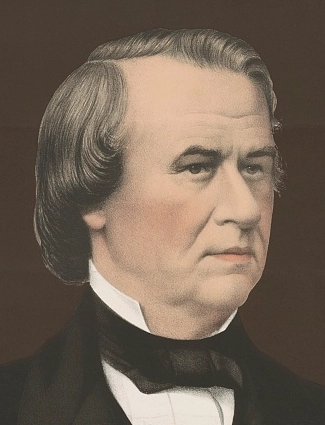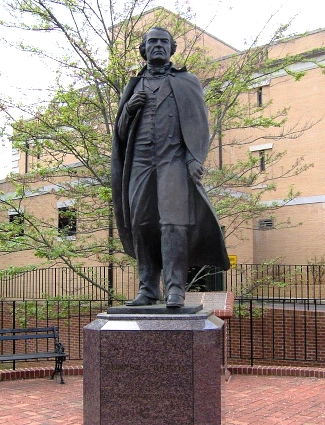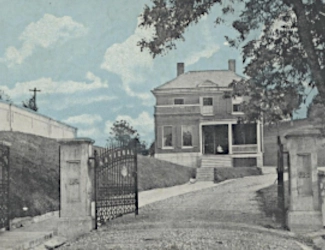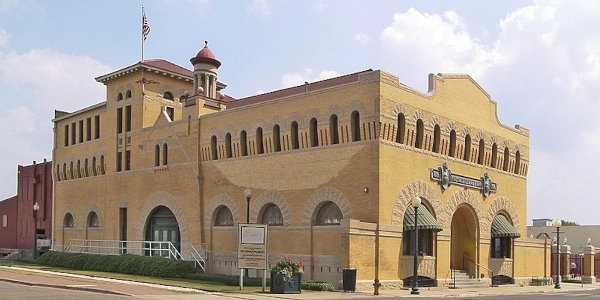
Image above: Portrait of President Andrew Johnson, 1866, Bingham and Dodd. Courtesy Library of Congress.
Spotlight on Lesser Known History
Andrew Johnson NHS
America's Best History Spotlight
On this page we're going to Spotlight the lesser known historic sites and attractions that dot the history landscape across the USA and are worth a visit if you're in their area. And while they may be lesser known, some are very unique, and will be that rare find. You'll be, at times, on the ground floor, or maybe even know something others don't. It'll be fun. Visit them.

Andrew Johnson National Historic Site, Tennessee
He's sometimes forgotten by all but historians and sometimes reviled by them and others, mostly due to the mess he made with Reconstruction after the Civil War ended and Abraham Lincoln's death elevated him to President. He's sometimes confused with President Andrew Jackson. But make no mistake, the presidency of Andrew Johnson built the post-Civil War America that saw amendments about Civil Rights, for good, even though he oppossed one, and the stalling of true Civil Rights in a reconstruction era that eventually gave too much power back to Confederate politicians who had no intention to make black americans, or women, equal citizens. All that was not Jackson's fault, but a visit to his historic site tells both tales, and they are tales we should learn significant lessons from. Photo above: Engraving of Andrew Johnson's home in Greenville, Tennessee, in 1865, 1865, Marsh and Reiff. Courtesy National Park Service.
Sponsor this page for $100 per year. Your banner or text ad can fill the space above.
Click here to Sponsor the page and how to reserve your ad.
Info, What's There Now, History Nearby

Andrew Johnson NHS, Tennessee
Although Andrew Johnson is often misunderstood as a President, his story is a remarkable one. He never attended one day of school, yet rose to political office from the local level, to Governor, to Congress, then the Presidency, and back to the Senate. He deferred to the Constitution often, which put him at odds with Congress during the debates about freedmen's issues. He often had different opinions than the majority, even in his own Republican party, at the time. He favored almost immediate reinstatement of southern states into the Union, even before the amendments to safeguard them had passed. When Mary Surrat, the owner of the house where John Wilkes Booth stayed was put to trial and executed, Johnson stated,...
"The execution of Mrs. Surrat [sic] was a crime of passion without justice or reason. She knew no more about the intentions of Booth and his associates than any other preson [sic] who chanced to know Booth or Asterot. They had simply boarded as others had done, at her boarding house. She was entitled to trial in open court and the record of that trial preserved, but her executioners knew the records would condemn them if they kept till passion had subsided and they were destroyed," Andrew Johnson.
Why didn't President Johnson pardon her? He stated that it would have caused his death and riots that may have started war again.
Johnson was responsible for the freedom of four million men and women during his time in office through the passage of the 13th, 14th (Johnson opposed the 14th), and 15th amendments, but sparred with Congress on specifics of reconstruction. He used the veto pen more times than any President before him, which, in part, caused the call for his impeachment.
Johnson's beliefs were complicated; he owned ten slaves, freeing them on August 8, 1863. To this day, many historians think of him as one of the worst Presidents in history.
Image above: Andrew Johnson National Historic Site, unknown date, Moody Studios. Courtesy National Park Service. Below: Andrew Johnson's Tailor Shop, Unknown date and author. Courtesy National Park Service.

Where Is It
Andrew Johnson National Historic Site is located in Greeneville, Tennessee with the Visitor Center located 101 North College Street, Greeneville, TN. There is another aspect to the park, which is the Andrew Johnson National Cemetery, which is accessed from the west off East Vann Road. Greeneville is south off I-81, west of Johnson City and east of Knoxville.
What is There Now
Andrew Johnson NHS
First stop should probably be the Visitor Center, which is open daily in summer, and located two and one half blocks from the Homestead. However, inside the Visitor Center, there's lots to do and look at, including a Memorial Building, inside which Johnson's original Tailor Shop stands, a film called "Defender of the Constitution," plus orientation, a museum, and a bookstore. Outside the building there's a statue of President Johnson. The Homestead, as noted before, is down the street on Main Street.
When Open and How Much
The Homestead is open during the summer months for guided ranger tours four times per day, starting at 10:30 a.m. If you're going from December to April, call to check for the appropriate days and hours. There is onsite parking at both the Visitor Center and the Homestead. Admission is free.
Fees subject to change.
Websites
Andrew Johnson National Historic Site
History Nearby
Located off Route 81 in eastern Tennessee, you're close to so much natural and man-made history, that your tour to Andrew Johnson NHS is likely to include more sites. Coming from the north, there's Cumberland Gap National Park; from the south, Rocky Mountain National Park, and many others.
Buy Chronology

Great Book for the History Fan with Fifty Short Essays Telling the Story of American History.
Photos, History, and More Spotlights

Andrew Johnson at Greeneville
Andrew Johnson opened his Tailor Shop, learning to read while turning the shop into a thriving business. "When I was a tailor I always made a close fit, and was always punctual to my customers, and did good work," Andrew Johnson. He at first lived in another house, across the street from the Visitor Center, and not the Homestead.
While Vice President during the Civil War, his home was used as headquarters for both the Union and Confederacy. Johnson, even though from a Confederate state, remained firmly a Unionist. Johnson would return back to the Homestead after his presidency, and use it as his residence again. He would become the only President ever elected to the U.S. Senate after holding the highest office.
The Andrew Johnson Homestead was designated a national monument in 1935.
Lodging is plentiful around Greeneville with bed and breakfasts, motels, and the General Morgan Inn, or you could go deeper into the woods for a Tennessee cabin or campground. Check with the local tourist bureau or your favorite online lodging site for ideas.
Photo above: Statue of Andrew Johnson at Andrew Johnson National Historic Site, 2008, Brian Stansberry. Courtesy Wikipedia Commons, C.C. 3.0.

Impeachment
It was Thaddeus Stevens who announced Johnson's impeachment to the U.S. Senate. It was the first impeachment in United States history. The charges were a tenuous struggle between Congress and the President for power. After Congress overrode Johnson's veto of the Tenure of Office Act, which stated that Congress had to approve of a President's removal of appointed officials, Johnson removed Secretary of War Edward Stanton anyway. He thought the act was unconstitutional. Johnson had other reasons; Stanton had withheld information about the New Orleans riots from the President.
The House of Representatives brought eleven counts of impeachment against him; the Senate held trial from March to May 1868. The first vote on May 16 was 35 guilty, 19 not guilty, one vote shy of the two-third majority needed. Two more articles were voted on with the same outcome.
President Johnson would finish out his term as the 17th President of the United States. In 1926, all Tenure of Office Acts were ruled unconstitutional.
Photo above: Engraving of the Impeachment of President Andrew Johnson in the U.S. Senate, 1868, T.R. Davis for Harpers Illustrated. Courtesy Library of Congress.

Andrew Johnson National Cemetery
Andrew Johnson was buried atop what now is known as Monument Hill, but was known as Signal Hill at the time of his passing. It is located west of the Visitor Center off East Vann Street and not accessible from the Visitor Center parking area, except by foot. The entire area is now a national cemetery since 1906. Johnson's grave is marked by an obelisk atop which stands an eagle.
Photo above: Entrance to the Andrew Johnson National Cemetery, unknown date and author. Courtesy National Park Service.

T-Shirts and Gifts from the official souvenirs of Americasbesthistory.com.
About
America's Best History where we take a look at the timeline of American History and the historic sites and national parks that hold that history within their lands.
Photos courtesy of the Library of Congress, National Archives, National Park Service, americasbesthistory.com and its licensors.
- Contact Us
- About
- © 2022 Americasbesthistory.com.
Template by w3layouts.


